
Pashupatinath area with the golden roof of the Pashupatinath temple. (795k)
Kathmandu is the main city in the Kathmandu Valley in Nepal. The Kathmandu Valley is a UNESCO World Heritage Site.
It was originally called Kantipur, City of Glory. The name Kathmandu comes from the unique temple that stands in Durbar Square called Kasthamandap.
The oldest finds in Kathmandu date from about 185 CE. There are few historical records from the early period.
In medieval times, Kathmandu was ruled by the Licchavi dynasty. A Licchavi ruler, Gunakamadeva, founded the city of Kathmandu in 723 CE. Kathmandu was an important stop on the ancient trade routes between Tibet and India.
In 1200, the first Malla King, Ari Deva Malla came to power. The Malla Kings ruled Kathmandu Valley till 1482, when the valley was split up into three kingdoms in Kantipur, Lalitpur, and Bhaktapur.
The Malla Dynasty ruled till when Prithvi Narayan Shah of Gorkha invaded and conquered the valley, thus inaugurating the Shah dynasty of Nepal.
This page has descriptions of some of the major sites in Kathmandu: Boudhanath Stupa, Swayambhunath (Monkey Temple), and Pashupatinath.
Kathmandu Durbar Square is described on a separate page.
All pictures are © Dr. Günther Eichhorn, unless otherwise noted.
Pashupatinath Temple is one of the most significant Hindu temples of Lord Shiva in the world, located on the banks of the Bagmati River in the eastern part of Kathmandu. The temple served as the seat of the national deity, Lord Pashupatinath. It is part of the Kathmandu Valley UNESCO World Heritage Site. It probably dates back to the 4th century CE.
One of the legends about its founding is the Cow Legend:
Shiva and Parvati came to the Kathmandu Valley and rested by the Bagmati while on a journey. Shiva was so impressed by its beauty and the surrounding forest that he and Parvati changed themselves into deer and walked into the forest. Many spots in the Kathmandu Valley are identified as places where Shiva went during his time as a deer. After awhile the people and gods began to search for Shiva. Finally, after various complications, they found him in the forest, but he refused to leave. More complications ensued, but ultimately Shiva announced that, since he had lived by the Bagmati in a deer's form, he would now be known as Pashupatinath, Lord of all Animals. By grabbing him by the horn, the Gods forced him to resume his divine form. The broken horn was worshiped as a lingam of Pashupatinath, but overtime it was buried and lost. Centuries later an astonished herdsmen found one of his cows showering the earth with milk every day. Digging deep at the site, he discovered the divine lingam of Pashupatinath. The people then build a temple to honor Lord Shiva in the form of Pashupatinath.
The temple was rebuild numerous times over the centuries. It is for Hindus like Mecca is for Muslims, or Jerusalem for Jews.
Around the Pashupatinath Temple are many smaller temples and shrines. There are always lots of Sadhus (Holy Men) in the area.
Along the Bagmati River near the Pashupatinath Temple are cremation sites. One is for the royal family only, and one is for important dignitaries. The one for the royal family was last used after the Royal Massacre on 1 June 2001, in which most of the royal family was killed.
The cremation sites are not exclusively for Hindu, they can be used by others as well.
The deceased is cleansed in the river and then clothed in an orange robe. S/he is carried in a procession to the cremation pad and placed on the wood pyre. After cremation, the ashes are swiped into the Bagmati river.

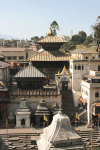
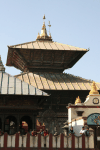

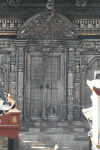
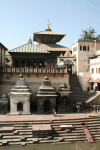







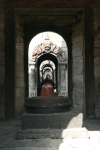
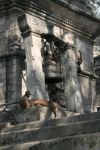


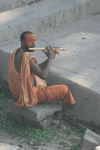
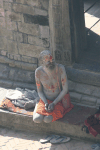

Boudhanath is one of the holiest Buddhist sites. The ancient Stupa is one of the largest in the world. Boudhanath is is part of the Kathmandu Valley UNESCO World Heritage Site. It dates probably from the 4th century CE.
The Stupa is on the ancient trade route from Tibet. It is the holiest site for Tibetan Buddhists. Many of them settled near it when they fled Tibet after the Chinese invasion of Tibet in the 50's.
According to legend, Kasyapa was a Buddha that lived a long time before Shakyamuni Buddha. After Kasyapa Buddha's demise, an old woman, Shamvara, with her four sons, interred this great sage's remains at the spot over which the great mound now stands. Before starting on the work of construction for the monument, she petitioned the King of the time about building it. He promised as much land as the hide of a buffalo can cover. She cut the hide of a buffalo in such a way that in one continuous strip it formed the circumference of an enormous plot. By the time that, as a result of great sacrifices on the part of the woman and her four sons, the groundwork of the structure had been finished, those who saw it were astonished at the greatness of the scale on which it was undertaken. Especially was this the case with the high officials of the country, who all said that if such a poor old dame were allowed to complete building such a stupendous tower, they themselves would have to dedicate a temple as great as a mountain, so they decided to ask the King to disallow the further progress of the work. When the King was approached on the matter his Majesty replied: "I have given the permission to the woman to proceed with the work. Kings must not eat their words, and I cannot undo my orders now." So the tower was allowed to be finished. The Tibetan name for the stupa, Jhyarung Khasyor, means "I have given the order, I can't take it back."
From above, Boudhanath Stupa looks like a giant mandala, or diagram of the Buddhist cosmos. And as in all Tibetan mandalas, four of the Dhyani Buddhas mark the cardinal points, with the fifth, Vairocana, enshrined in the center (in the white hemisphere of the stupa). The five Buddhas also personify the five elements (earth, water, fire, air and ether), which are represented in the stupa's architecture.
At the bottom, the stupa is surrounded by an irregular 16-sided wall, with frescoes in the niches. In addition to the Five Dhyani Buddhas, Boudhanath Stupa is closely associated with the Bodhisattva Avalokiteshvara (Padmapani), whose 108 forms are depicted in sculptures around the base. The mantra of Avalokiteshvara - Om Mani Padme Hum - is carved on the prayer wheels beside the images of Avalokiteshvara around the base of the stupa.
The base of the stupa consists of three large platforms, decreasing in size. These platforms symbolize Earth, and here you can look out at the mountains while listening to the chants of the devout doing kora, walking around the stupa praying.
Next come two circular plinths supporting the hemisphere of the stupa, symbolizing water. As at Swayambhunath, Boudhanath is topped with a square tower bearing the omnipresent Buddha eyes on all four sides.
Instead of a nose there is a question-mark-type symbol that is actually the Nepali character for the number 1, symbolizing unity and the one way to reach enlightenment through the Buddha's teachings. Above it is the third eye, symbolizing the wisdom of the Buddha.
The square tower is topped by a pyramid with 13 steps, representing the ladder to enlightenment. The triangular shape is the abstract form for the element of fire. At the top of the tower is a gilded canopy, the embodiment of air, and above it a gilded spire, symbolic of ether and the Buddha Vairocana. Prayer flags tied to the stupa flutter in the wind, carrying mantras and prayers heavenward. The prayer flags have five colors, symbolizing the five elements (red: fire, yellow: earth, blue: sky, green: water, white: wind).

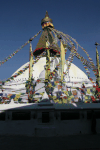



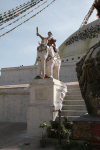




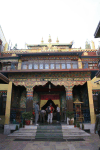
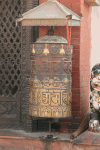
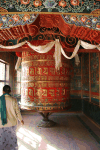
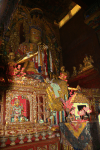


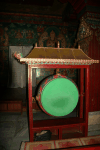
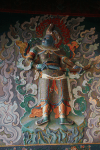

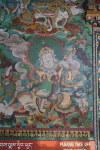
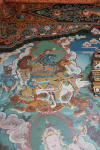
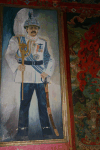
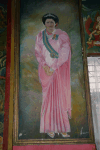
Swayambhunath is an ancient religious complex atop a hill in the Kathmandu Valley, west of Kathmandu. It is one of the most sacred among Buddhist pilgrimage sites, as important as the Boudhanath Stupa.
According to legend, the entire valley was once filled with an enormous lake, out of which grew a lotus. The valley came to be known as Swayambhu, meaning "Self-Created." The Bodhisattva Manjusri had a vision of the lotus at Swayambhu and traveled there to worship it. Seeing that the valley can be good settlement and to make the site more accessible to human pilgrims, Manjusri cut a gorge at Chovar. The water drained out of the lake, leaving the valley in which Kathmandu now lies. The lotus was transformed into a hill and the flower become the Swayambhunath stupa.
Swayambhunath is among the oldest religious sites in Nepal, it dates from the early 5th century CE.
Although the site is considered Buddhist, the place is revered by both Buddhists and Hindus.
The stupa was completely renovated in May 2010, its first major renovation in 90 years and its 15th in the nearly 1,500 years since it was built. The dome was re-gilded using 20 kg (40 lb) of gold. The renovation was funded by the Tibetan Nyingma Meditation Center of California, and began in June 2008.
The site has two access points: a long stairway, claimed to have 365 steps, leading directly to the main platform of the temple, which is from the top of the hill to the east; and a car road around the hill from the south leading to the southwest entrance. The first sight on reaching the top of the stairway is the huge Vajra, the Thunderbolt, the symbol of male power. It is an impressive sight.
For the symbolism of the stupa itself, see the description of the Boudhanath Stupa.
The site is covered with small Buddhist monuments. These monuments were donated in memory of deceased family members. Nowadays there is no room left to put up any new monuments.
Next to the stupa is a Hindu temple dedicated to Harati, the Goddess of smallpox and other epidemics. The presence of the Harati Devi temple signifies the intermingling of the pantheons of Hinduism and Buddhism in the development of the religious trends of Nepal. As Buddhists had no deity in their own pantheon to protect against the dreaded smallpox, they adopted the Hindu deity for assistance.
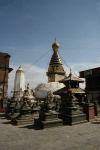
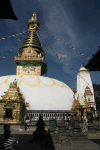
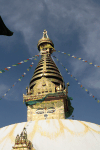
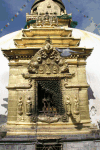
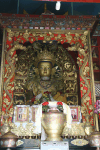
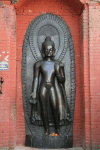

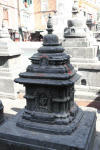
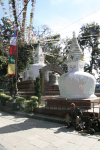
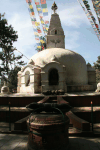
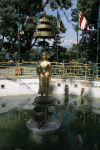
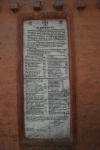

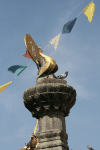

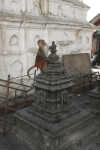
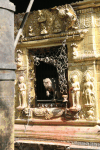
Here are some pictures from the streets of Kathmandu.
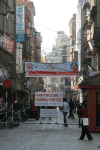












This page contains 73 pictures
Page last updated on Mon Jan 20 14:49:23 2020 (Mountain Standard Time)
Page last updated on Thu Apr 25 19:45:13 2024 (Mountain Standard Time)
Architecture in Kathmandu on gei.geichhorn.com